|

|
 |

|
|
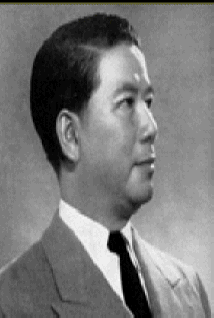
South
Vietnams President Ngo Dinh
Diem |
The
Vietnam War was a failure by France to suppress nationalist forces in Indochina
as it struggled to restore colonial domain after the World War 2. Led by Ho Chi
Minh, Vietnam had gained there independence from France in the year of
1954. On May 7, 1954 Vietnam forces occupied French command post at Dien Bien
Phu the commander ordered troops to cease fire. The battle lasted 55 days,
3,000 French troops were killed, 8,000 wounded. The Viet Minh suffered worse
with 8,000 dead and 12,000 wounded, but the Vietnamese victory shattered
Frances resole to carry on the war. Vietnam is divided into a north and a
South. The North was the communist country and Led by Ho Chi Minh and the South
was the anti-communist country and led by Ngo Dinh Diem. |
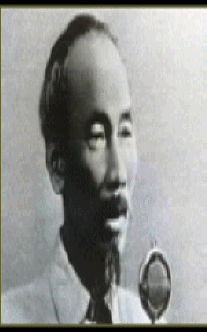
North Vietnams President
Ho Chi Minh |
|
|
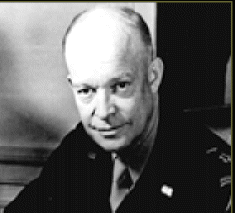
U.S. President
Dwight D. Eisenhower
|
The involvement of the United States was to stop
the spread of communist in Southeast Asia. To accomplish this the United
States helped South Vietnam, Also called the Republic of Vietnam. The
United States sent an army of over 500,000 men. The U.S. involvement had
began during the administration of Dwight D. Eisenhower (1953-1961) Which
had sent U.S. Military groups to South Vietnam. Their numbers had
increased as the military position in Saigon became weaker. In 1957 the
communist rebels- Viet Cong- had began a campaign of terrorism is
South Vietnam. The North's goal was to overthrow the anti-communist government
in South Vietnam. |
|
John F. Kennedy (1961-1963)
had decided to commit American troops to South Vietnam,
4,000 troops were sent in 1962. After JFK was assassinated, the vice
President London B. Johnson had served the last 14 months of JFK's term.
In January 1965 Johnson was elected for his own full term. |
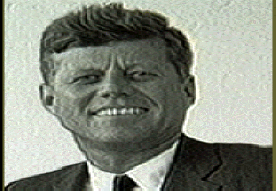
U.S. President
John F. Kennedy
|
|
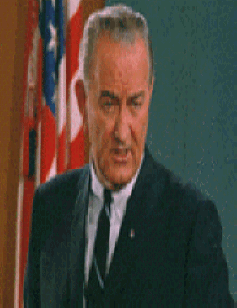
U.S. President
London B. Johnson
|
Under
President London B. Johnson (1963-1968) the US Inter Vertion mushroomed
both the military and politically, General William C. Westmoreland's strategy
of search and destroy would force the communist to expand supplies and
make the logistics establishment in the North Vietnam all the more vulnerable
to bombing. On August 4 captain of U.S.S. Maddox reported that his vessel
had been fired at. American jets bombed 2 naval bases and destroyed a major
oil facility. 2 U.S. planes were downed in the attack. Then on April 7,
1965 the U.S. offers the North Vietnam some economic aid for peace, the
offer was rejected. 2 weeks later the American combat strength in Vietnam
more than 60,000 troops. By the end of 1966 forces in Vietnam reached
385,000 men, plus 60,000 sailors stationed offshore. |
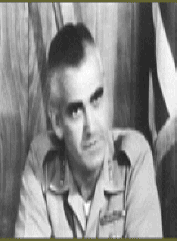
U.S. General
William C. Westmorland |
| The helicopter became
a prime hover of artillery giving them increase mobility. The helicopter
and its rapid fire often spelled the difference between victory and
defeat. when General Creighton Abrahams took over command in the spring of
1968 the focus on ground operations turned to " Strategic
hamlets" with population security as its goal. |
| In 1965 U.S. air
strikes were ordered against North Vietnam. By late 1965, such air strikes
had became part and parcel to daily activities of those stationed in Vietnam.
U.S. forces didn't attack some targets for the fear of Chinese
retaliation. By spring of the later year some 50,000 Chinese troops served
in North Vietnam. By April 24, 1967, American attacks on the North Vietnamese
on airfields began, and the damaged runways and installations. By
the end of the year all but 1 of Miss bases had been hit. |
|
Date |
Total Personnel |
|
December 31,1960 |
900 |
| December 31,1961 |
3,200 |
| December 31,1962 |
11,500 |
| December 31,1963 |
16,300 |
| December 31,1964 |
23,300 |
| December 31,1965 |
184,300 |
| December 31,1966 |
425,300 |
| December 31,1967 |
485,600 |
| December 31,1968 |
536,100 |
| December 31,1969 |
474,400 |
| December 31,1970 |
335,800 |
| June 9, 7971 |
250,900 |
|
| In
March 1965 first American ground troops arrived in south Vietnam. By
July, 125,000 Americans were fighting in Vietnam. In December U.S. halted air attacks
to see if the North Vietnamese would negotiate an end to fighting the war.
They refused, Ho Chi Minh' for peace was firm. In 1966 Johnson renewed
bombing attack and increased the number of troops that were sent into
North Vietnam. He condemned those who opposed his politics: he said "
The American people still stand united every soldier is brought home safely.
They will stand united until the people of South Vietnam can choose
their own government." |
|
Richard M. Nixon (1969-1974) was elected a claim that he had a
"secret plan" for honorably disengaging American troops, which succeeded
initially only in intensifying the conflict. This last phase of American involvement
in the South Vietnam was carried out under broad policy called
Vietnamization. It's main goal was to create strong, large self-reliant
South Vietnamese military force. |
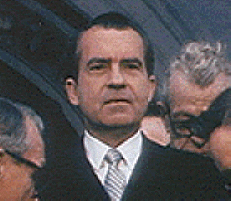
U.S. President
Richard Nixon |
| By April 1969 U.S.
combat deaths in Vietnam had exceeded 33, 629 men killed in the Korean
War. Then on June 8, 1969 Nixon met with Southern Vietnamese
President Nguyen Van Thien on the Midway Island in the pacific, and
announced that 25,000 U.S. troops will be withdrawn immediately.
August 9, 1974 Nixon resigns, leaving South Vietnam without it's strongest
advocate. March 25, 1975 Hue, South Vietnams third largest city falls to
the North Vietnamese Army. |
| By Spring of 1972 the Vietnam
War was at low ebb. After the invasion of Cambodia in
May 1970, there was little fighting in South Vietnam. To help build
up the South Vietnams military the pentagon ordered a rush deliveries of
some $2 billion worth of military Equipment, including over 600 aircrafts
which gave South Vietnam ethic 4th largest air force in the world with
over 2,000 aircrafts, and the 5th largest navy (with 1,500 ships) , and
the 4th largest army in the world (with 1.1 million troops). |
|
U.S. Women in
Vietnam |
| Although
the Pentagon Sources estimate that 1,234 military women other than nurses
had served throughout the war, the exact number is really unknown.
The women served in various positions, such as personnel, administrative,
logi communications, finance, intelligence, operators, advisors, public
inform military justice, flight controllers, and in a myriad of other
duties. |
| The
first Womens Army corps (WAC) person to serve in Vietnam was Major Anne
Marie Doering (1962 to 1963). The daughter of a French engineer, she
was born and raised in Haiphorg and she spoke fluent Vietnamese. She
had been assigned to the military Assistance Group (M.A.A.G.) in Saigon as a
plans officer. |
|
Originally, the Army had fought sending women other than nurses into
Vietnam COL Shirley R. Heinze had waged a winning battle with the top
Brass. Major Audrey Fisher was the first W.A.C. officer assigned to
Headquarters U.S. Army Vietnam with the Office of Adjutant General. |
|
January 12, 1967 the first war enlisted to serve at Headquarters U.S. Army
Vietnam (U.S.A.R.V.), Tan Son Mhut. Six months later, along with the
entire U.S. Army Vietnam commands the de tachment moved to Long Binh,
approximately 27 miles northeast of Saigon. By early 1970, more than 130
enlisted W.A.C's, 30 Arny officers, and 5 Army warrant officers were serving
throughout Vietnam. |
| The first
member of the Army Medical Specialist Corps (M.A.C.V.) to serve in Vietnam
was a physical therapist who had volunteered for Vietnam Major Barbara
Gray had been assigned to the 17th Field Hospital. in Saigon, March
1966. |
| Between
March 1966 and February 1973, 33 Female Army physical therapists served in
South Vietnam. The last Army dietitian and the last physical
therapist to serve in Vietnam, both being women, left Saigon for home on
February 1973. |
|
|
|
Bibliography |









